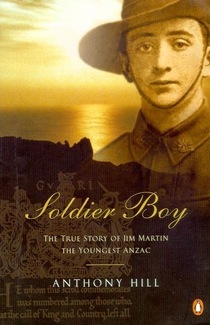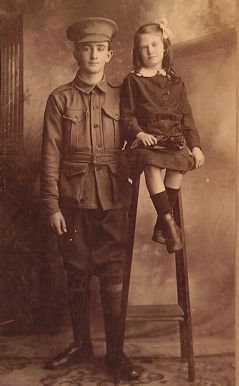For something like two years I tried to forget this book I’d called War Games. To put it completely out of my mind, and suppress the spasms of guilt I still felt about the money Penguin had advanced me.
Yet every bit as unexpectedly as the idea had collapsed – for each book is an artifice, a construct – the material presented itself to me again in a new but properly conceived form. Just as my publisher, Julie Watts, said that it would.
Gallipoli
I was writing speeches at the time for the Governor-General, who represents The Queen in our country. It was with Bill Hayden that I’d been to Gallipoli in April 1995 for the 80th anniversary of the Anzac Day Landings. Now in 1999 his successor, Sir William Deane, was making the pilgrimage, and I was researching the words he would speak.
 Among the briefing notes that came to us from the Australian War Memorial was a page from Robertson’s Anzac and Empire. In the margin was the photograph of a young soldier, James Martin, with the saddest eyes, and a caption that said he died of disease and was buried at sea off Gallipoli at the age of only 14.
Among the briefing notes that came to us from the Australian War Memorial was a page from Robertson’s Anzac and Empire. In the margin was the photograph of a young soldier, James Martin, with the saddest eyes, and a caption that said he died of disease and was buried at sea off Gallipoli at the age of only 14.
He was probably the youngest Anzac (though you can’t be sure for amount of lying), but is almost certainly the youngest Australian soldier to die.
I put Jim’s name in the speech for Lone Pine where he is commemorated. And then I remember quite clearly standing up at my desk and saying out loud, ‘There’s a book in you!’ And so indeed there was.
I went to the AWM and found that his family had deposited a lot of material some years earlier: photographs, five letters (I was able to find a sixth during the research), memorabilia including his dog tag, money belt, an embroidered cushion cover he’d sent from Egypt ‘To Mother With Love From Jim.’ It was amazing nobody had written his book earlier.
There were the battalion war diaries and embarkation rolls in the official collections. I got his service papers from the National Archives, including a letter of permission from his parents. And I was given a contact with Jim’s nephew, Jack Harris, who lives not far from me in Canberra.
Jim's family
 Does he look 14? Jim with his sister Millie, 1915.
Does he look 14? Jim with his sister Millie, 1915.
I have to acknowledge the generosity the family showed me. Jack talked at length of the stories he was told as a boy about his uncle Jim who’d lied and gone to Gallipoli. He introduced me to other family members. More photos, another letter, medals, pages from the family Bible came to light.
I visited the lad’s school in Melbourne, and spent many hours at the National Library going through the newspapers and directories, reflecting the while how blessed we authors are in Canberra with the research facilities available to us.
Gradually I was building a version of Jim Martin’s brief life and tragic times, and at length began to write it down. There is much I could say about the process – it was the first book I composed directly on the computer; decisions we had to make on form and structure; questions of voice, titles, opening paragraphs and so on – but I’ll save those for later posts.
The point I make here is that from the beginning the writing flowed easily and naturally. The metaphors rose of their own accord from the subject. Here was a story worth telling to those thousands of young people who gather in the dawn every 25th of April near Anzac Cove.
This, I could now say, is what the Gallipoli campaign was like … what war has always been like. And all at once, as I was writing of Jim enlisting and his army training, much of that material I’d collected at Canungra for the failed War Games manuscript began to find its place, just as Julie Watts said it would.
The more things change...
To be sure the technology of modern warfare is vastly different to what it was in 1915. But the etiquette of the rifle range is much the same, as it is in the bayonet practice yard. Charge. Scream. Thrust. Twist. ‘Take that you rotter!’ (or colloquial words to the same effect). The relationships between officers, NCOs and other ranks haven’t changed very much; nor have they among the soldiers themselves.
If such things read truthfully in the pages of Soldier Boy, then it’s because they are real. They come from observed experience, stored for as long as necessary in one’s memory, and transformed when needed by a writer’s art into literature worth reading.
Author and subject: by Jim's name at the Lone Pine Memorial, Gallipoli.
So I was able to email back to my friend who’d been so helpful at Battle Wing, Canungra, all these years ago, and say that while the book I was then researching had been stillborn, the material found new life in an entirely different book, which has been far and away my most successful publication.
And I’d say to those of you who sometimes wonder where ideas for books come from, that they’re all around us. Everywhere. In a place like Anzac Cove at first light. In an anecdote, such as Don told of turning 21 in Vietnam. In the caption to a photo in a book you’re reading. You’ve only got to be receptive; and to your own surprise you may also find yourself saying out loud, ‘There’s a book in you!’ For you will have found whatever it is that you want to say.
And never never never throw anything completely away. As Julie truly remarked, ‘Nothing ever goes to waste in this business.’
Photo credits:
Soldier Boy cover: courtesy Penguin Books Australia,
Jim with Millie, 1915: courtesy Martin family.
Author and subject – the commemorative wall, Lone Pine 2012: author photo.
